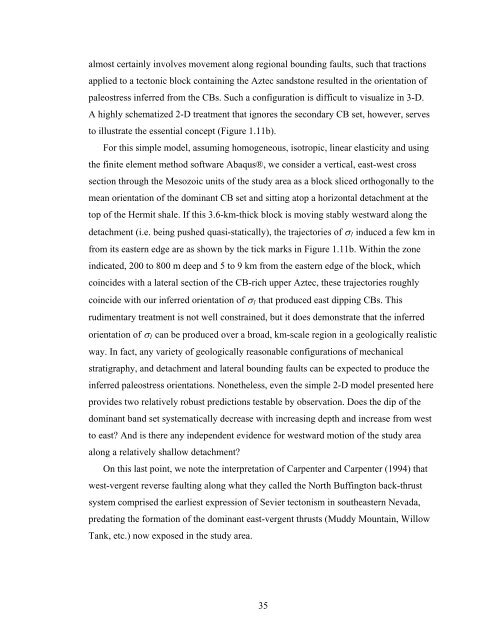structural geology, propagation mechanics and - Stanford School of ...
structural geology, propagation mechanics and - Stanford School of ...
structural geology, propagation mechanics and - Stanford School of ...
Create successful ePaper yourself
Turn your PDF publications into a flip-book with our unique Google optimized e-Paper software.
almost certainly involves movement along regional bounding faults, such that tractions<br />
applied to a tectonic block containing the Aztec s<strong>and</strong>stone resulted in the orientation <strong>of</strong><br />
paleostress inferred from the CBs. Such a configuration is difficult to visualize in 3-D.<br />
A highly schematized 2-D treatment that ignores the secondary CB set, however, serves<br />
to illustrate the essential concept (Figure 1.11b).<br />
For this simple model, assuming homogeneous, isotropic, linear elasticity <strong>and</strong> using<br />
the finite element method s<strong>of</strong>tware Abaqus®, we consider a vertical, east-west cross<br />
section through the Mesozoic units <strong>of</strong> the study area as a block sliced orthogonally to the<br />
mean orientation <strong>of</strong> the dominant CB set <strong>and</strong> sitting atop a horizontal detachment at the<br />
top <strong>of</strong> the Hermit shale. If this 3.6-km-thick block is moving stably westward along the<br />
detachment (i.e. being pushed quasi-statically), the trajectories <strong>of</strong> σ1 induced a few km in<br />
from its eastern edge are as shown by the tick marks in Figure 1.11b. Within the zone<br />
indicated, 200 to 800 m deep <strong>and</strong> 5 to 9 km from the eastern edge <strong>of</strong> the block, which<br />
coincides with a lateral section <strong>of</strong> the CB-rich upper Aztec, these trajectories roughly<br />
coincide with our inferred orientation <strong>of</strong> σ1 that produced east dipping CBs. This<br />
rudimentary treatment is not well constrained, but it does demonstrate that the inferred<br />
orientation <strong>of</strong> σ1 can be produced over a broad, km-scale region in a geologically realistic<br />
way. In fact, any variety <strong>of</strong> geologically reasonable configurations <strong>of</strong> mechanical<br />
stratigraphy, <strong>and</strong> detachment <strong>and</strong> lateral bounding faults can be expected to produce the<br />
inferred paleostress orientations. Nonetheless, even the simple 2-D model presented here<br />
provides two relatively robust predictions testable by observation. Does the dip <strong>of</strong> the<br />
dominant b<strong>and</strong> set systematically decrease with increasing depth <strong>and</strong> increase from west<br />
to east? And is there any independent evidence for westward motion <strong>of</strong> the study area<br />
along a relatively shallow detachment?<br />
On this last point, we note the interpretation <strong>of</strong> Carpenter <strong>and</strong> Carpenter (1994) that<br />
west-vergent reverse faulting along what they called the North Buffington back-thrust<br />
system comprised the earliest expression <strong>of</strong> Sevier tectonism in southeastern Nevada,<br />
predating the formation <strong>of</strong> the dominant east-vergent thrusts (Muddy Mountain, Willow<br />
Tank, etc.) now exposed in the study area.<br />
35
















